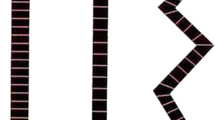Abstract
The muscle spindles (MS) have been proposed by Merton (1953), to be the sensors supplying a feedback signal in the muscle length follow-up servo system. This system is analyzed here, based on the two engineering requirements for man made servo systems, namely the system loop gain and the steady state error (Gille, 1959). In the first part the system's linearized transfer function equations are developed. It is shown that the small loop gain found in the reflex studies indicates a small gain under volitional control of movements, i.e. volitional control is being exercised directly by the alpha or gamma system. For the steady state error no definite conclusions can be drawn from the available data (Rosenthal, 1970; Houk, 1963); however, it is shown to be inversely proportional to the steady state loop gain, and the system is thus of type “0” or “1”.
Similar content being viewed by others
References
Eldred,E., Granit,R., Merton,P.A.: Superspinal control of muscle spindles and its significance. J. Physiol. (Lond.) 122, 498–523 (1953).
Gille,J., Pelegrin,M., Decaulne,P.: Feedback control systems. McGraw-Hill, Book Co. 1959.
Granit,R.: Receptors and sensory perception. New Haven: Yale University Press 1962.
Houk,J.C, Singer,J.J., Goldman,M.R.: An evaluation of length and force feedback to soleus muscles of decerebrate cats. J. Neurophysiol. 33, 784–811 (1970).
—, Henneman,E.: Responses of Golgi tendon organs to active contractions of the soleus muscle of the cat. J. Neurophysiol. 30, 466–481 (1967).
—: A mathematical model of the stretch reflex in Human muscle systems. M. Sc. Dissertation. Cambridge: M.I.T. (1963).
Inbar,G.F., Odom,B., Wagman,I.: Muscle spindles in muscle control: I. Afferent outflow from frog muscle spindles in open and closed loop modes. Kybernetik 11, 119–122 (1972).
Josef,P., Inbar,G.F.: Steady state errors in muscle servo systems. Proc. Fifth Hawaii International Conference on System Sciences Session HH-3 (1972).
Matthews,P.B.C., Stein,R.B.: The sensitivity of muscle spindles afferents to small sinusoidal changes of length. J. Physiol. (Lond.) 200, 723–743 (1969).
—: The reflex excitation of the soleus muscle of the decerebrate cat caused by vibration applied to its tendon. J. Physiol. (Lond) 184, 450–472 (1966).
Merton,P.A.: Speculations on the servo-control of movement. In: The spinal cord, p. 247–260. Malcolm,J.L., Gray,J.A.B., Wolstenholrn (Ed.) Boston: Little, Brown & Co., 1953.
Roberts,T.D.M.: Neurophysiology of postural mechanism, New York: Plenum Press, 1967.
Rosenthal,N.P., Mckean,T.A., Roberts,W.J., Terzuolo,C.A.: Frequency analysis of stretch reflex and its main subsystems in triceps surae muscles of the cat. J. Neurophysiol. 33, 733–749 (1970).
Terzuolo,C.: Personal communication.
Stark,L.: Neurological control systems. New York: Plenum Press 1968.
Author information
Authors and Affiliations
Rights and permissions
About this article
Cite this article
Inbar, G.F. Muscle spindles in muscle control. Kybernetik 11, 123–129 (1972). https://doi.org/10.1007/BF00270668
Received:
Issue Date:
DOI: https://doi.org/10.1007/BF00270668




